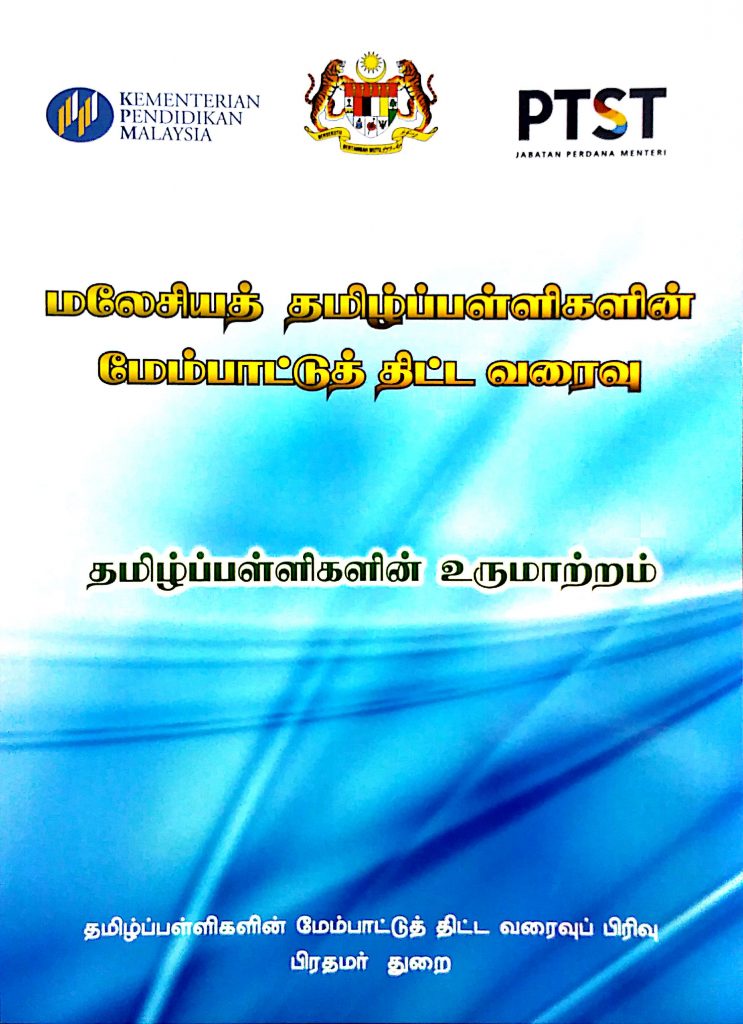Tamil Schools and Tamil Education in Malaysia have a history of dating back to more than 200 years ago. It was a historic moment when the Government in 2012 created a dedicated unit – Action Plan for the Future of Tamil Schools – at the Prime Minister’s Department address the various problems faced by these schools, and to complement the work of the Ministry of Education in finding solutions to problems faced by these schools.
For the comprehensive and sustainable development of these schools, the Hon. Prime Minister Dato’ Seri Mohd Najib bin Tun Abdul Razak directed that a Blueprint for Tamil Schools be developed. This Blueprint for Tamil Schools was officially launched on February 14, 2014 and was handed-over to the government.
***Below are the excerpts from the Action Plan for the Future of Tamil Schools – Blueprint. (Prime Minister’s Department, 2014).
Introduction.
National Type Tamil schools (Sekolah Jenis Kebangsaan Tamil – SJKT) in Malaysia have a history of at least 150 years. The teaching of Tamil Language by volunteers, to safeguard their language and identity, started more than 200 years ago. This very important feature of the Indian community in Malaysia is also one of the many unique features of the Malaysian Education System. SJKT schools, without doubt, have played their part in producing the human capital for the country based on the National Philosophy of Education. These schools have shown tremendous improvement over the last 5 years (National Education Blueprint, 2012;19). This has been made possible with the joint effort of the Government, headmasters and teachers of these schools, parents, and the community as a whole.
Former Prime Minister Dato’ Seri Mohd Najib bin Tun Abdul Razak has on record implemented numerous initiatives since taking office in 2009 to improve SJKT schools. More than half a billion ringgit had been allocated to improve the infrastructure of development of SJKT schools in the last 5 years. He has also announced the building of six new SJKT schools.
Another very significant initiative by Hon. Prime Minister was the appointment of a Coordinator under the Prime Minister’s Department to produce a comprehensive Action Plan for the continuous and comprehensive development of SJKT schools. He has requested that the action plan be drawn up based on data collected from the existing 523 SJKT schools and through dialogue with all stakeholders in the community.
This report is the outcome of a comprehensive study undertaken between May 2012 and March 2013 to formulate a comprehensive and sustainable development plan for SJKT schools in Malaysia.
Background
Although the formal teaching of Tamil Language started in 1816 at Penang Free School by Rev. Hutchings (Rajendran, 2008), SJKT schools started to exist in Malaysia in the later part of the 19th century. There was a need to provide basic educational facilities to the children of the workers of the plantations administered by the British. Interestingly, these schools were started in the northern states such as Penang since the early arrival of Indians to Malaysia concentrated in Penang.
More SJKT schools were set up in the early part of the 20th century and there were significant increase in the number of SJKT schools in Malaysia after 1930s and after the second-world war. There were a total of 888 SJKT schools in Malaysia in the year 1957 (Rajendran, 2008), the year Malaysia gained its independence from the British. Largely due to fragmentation of estates and the migration of the estate workers to sub-urban areas, many of these schools closed down. Even today, the historical background of these schools, in particular the location of these schools, pose serious threats to the continuous existence of the SJKT schools. There are at least 15 SJKTs in the country with less than 10 students each.
The majority of the Indian community would like to ensure the continuous existence of these schools which are considered an important symbol of their language and culture. These schools have shown significant improvements in both infra-structure development and and in academic achievements over the years. These schools have closed the gap between them and other types of schools significantly in the recent years.
“ At the primary level, SJK( T) schools still lag behind both SJK (C) and SK schools by approximately 4 percentage points in 2011 ( Exhibit 3-25). However, this gap has been almost halved during the past five years……” (National Education Blueprint, 2012;19)
While this was the case prior to the release of the Ujian Penilaian Sekolah Rendah (UPSR) results of 2013, the SJKT schools further improved their performance. It is interesting to note that in the 2013 UPSR results, the SJKT schools have successfully closed the gap between them and other types of schools. The UPSR results of SJKT schools show that national average grade (GPN) of Tamil schools, had improved to 2.31 points in 2013 compared with 2.58 in 2010. The GPN of Tamil schools is only 0.04 points away from those of national schools. (A lower GPN score denotes better performance.)
To ensure the continuous, comprehensive and sustainable development of these schools, there has to be an Action Plan. This Action puts forward a comprehensive plan to ensure the continuous existence of SJKT schools in Malaysia. Besides evaluating the status of the schools and mapping out the challenges faced by these schools, this Action Plan aims to propose a comprehensive Action Plan to address all related issues to continue improving these schools, continue to receive the support from the community and most of all require the authorities to perform their duties to ensure the 100,000 children studying in these schools receive quality instruction.





